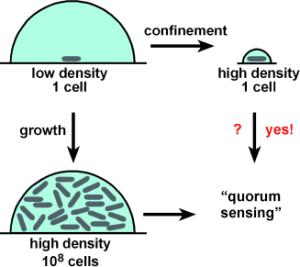|
Related Topics: |
|
|
|
Current News |
|
Chemistry A to Z |
|
About Internetchemistry |
A Matter of Density, Not Quantity |
|
Infections of wounds, pneumonia, etc. in hospitals in particular are often caused by bacteria called Pseudomonas aeruginosa. Once they reach a certain density, colonies of Pseudomonas aeruginosa produce virulence factors and can enter into a slimy state, a biofilm, which prevents antibiotics from penetrating. The process of quorum sensing, which cells use to “sense” cell density, is triggered when the concentration of certain signaling compounds generated by the bacteria reaches a threshold level. A team working with Rustem F. Ismagilov at the University of Chicago has now demonstrated that the absolute number of cells is irrelevant; only the number of bacteria in a given volume plays a role. As the researchers report in the journal Angewandte Chemie, they were even able to trigger quorum-sensing processes in single cells when these were confined in extremely small volumes. |
|
The term, quorum sensing, is derived from the Latin quorum; in politics, this is the number of votes that must be cast for an election or referendum to be valid. In biology, quorum sensing is defined as a process by which cells are able to detect the accumulation of a released signal and then change their behavior when the signal concentration exceeds a threshold level. Traditionally, quorum sensing is thought to help microorganisms to coordinate processes that would be inefficient in single cells, such as the formation of biofilms. Quorum sensing can also prevent too many bacteria from colonizing too small an area. However, the work of Ismagilov’s team has shown that quorum sensing is also activated by a single cell if the cell finds itself in an extremely enclosed space, which raises questions as to how quorum-sensing-regulated processes are relevant both to large colonies of cells and to single cells in confined spaces. In order to investigate this phenomenon, two different approaches can be taken: either seed a macroscopic volume with bacteria and wait for them to reach the required population through cell division, or enclose a few cells in an extremely tiny volume. The necessary signaling compounds can also become sufficiently concentrated by this route because the released signals cannot diffuse far away from the cell but instead accumulate around the cell. “In the past, the first strategy has dominated. This has led to the general view that quorum sensing is a process to coordinate the behavior of large groups of cells,” says Ismagilov. “This overlooks the possibility that small groups of cells could also initiate quorum sensing if they are confined to a sufficiently small volume. The quorum-sensing metabolic processes are relevant to a number of cellular functions, including the growth of small numbers of cells at the early stages of biofilm formation or the early stages of an infection.” By using a microfluidic experimental array, the team was able to isolate droplets with a volume of about 100 femtoliters (100 quadrillionths of a liter), each containing only one or very few cells of Pseudomonas aeruginosa. Even with these extremely low cell counts, the researchers were able to observe that quorum sensing was triggered in many cases. “This unambiguously refutes the notion that millions of cells are required for quorum sensing,” says Ismagilov. |
|
|
|

